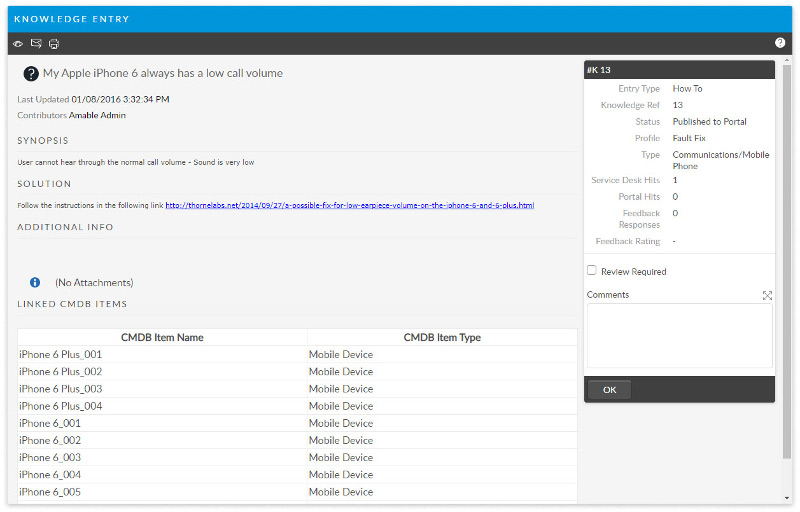Industry
Uses
Flexible Options
Services


Creating a well-organized ITSM knowledge base is crucial for effective IT Service Management. An ITSM knowledge base centralizes information, enabling quick access to resources like FAQs, troubleshooting guides, SOPs, and best practices. This guide covers the benefits of knowledge management and foundational steps to build and maintain an ITSM knowledge base, ensuring it remains an asset for IT teams and end-users alike.
First off, some essential definitions...
An ITSM knowledge base is a centralized repository for organized, searchable information essential to IT service management and optimal service delivery. It serves a broad range of users - such as IT staff, customers, and stakeholders - providing quick access to relevant documentation, training materials, procedures and other assets. Key features like search capabilities and user feedback options enhance accessibility and usability, ultimately improving productivity and customer satisfaction.
A knowledge base is typically created to support a specific purpose, such as providing customer support, facilitating employee training, or documenting internal processes. It can be accessed by a variety of stakeholders, including employees, customers, partners, and other users.
A knowledge asset is any piece of information or data that provides value to an organization and its stakeholders. Knowledge assets can include documentation, training materials, best practices, troubleshooting guides, FAQs, and workflows. These assets are stored in an ITSM knowledge base to be easily accessible, helping teams address recurring issues, improve decision-making, and streamline processes.
Knowledge assets displayed in Alemba Service Manager via Knowledge Search
ITSM knowledge management refers to the process of gathering, organizing, sharing, and maintaining knowledge assets in a knowledge base within an ITSM platform. The goal of ITSM knowledge management is to ensure that valuable insights and solutions are readily available to IT teams and end-users, which helps streamline ITSM processes and reduce the need for repetitive troubleshooting. Knowledge Management is one of the ITSM best practices set out in the ITIL framework.
Implementing an effective ITSM knowledge base provides a range of benefits that optimize ITSM solutions:
Research backs this up, such as this report from IDC revealing that robust knowledge management systems (KMS), significantly enhances organizational efficiency, improves business performance, and boosts customer satisfaction and productivity, resulting in a strong return on investment across departments.
Read how an Australian Government Department implemented a customer-facing knowledge base to help reduce Service Desk calls by up to 18% with Alemba Service Manager

Building a knowledge base requires careful planning, organization, and ongoing maintenance to ensure that it remains a valuable resource for users. Steps include:
Identify the primary purpose of the ITSM knowledge base - such as customer support or IT documentation - and outline the target audience and key objectives. Clarity on these foundational elements shapes the knowledge base’s structure and content.
Determine which types of content are essential for your ITSM tool. Different types of knowledge content include:
Identifying the right topics for inclusion may involve reviewing existing documentation, conducting interviews with subject-matter experts, or gathering user feedback.
The easiest way to get started is to look for the most commonly occurring issues - the “low-hanging fruit” - that represents on average about 80% of your total tickets logged to support.
Compose articles that will support this 80% first. By following the 80/20 rule, you can realize instant benefits whilst you refine and prepare more knowledge articles to bolster your knowledge base.
Example of a Knowledge entry in Alemba Service Manager
Establish a clear hierarchy with topics and subtopics. Use tags and keywords to categorize information, enhancing searchability and helping users navigate the ITSM platform effectively..
Designate content owners for specific sections and define a review process for regular updates. Incorporating user feedback also ensures content relevance and quality over time.
Selecting the right ITSM software to build the knowledge base is crucial. Ensure the platform supports access control, content versioning, and analytics to align with your organization's needs.


Alemba Service Manger is PinkVERIFY™ Certified for Knowledge Management as well as 18 other ITSM processes. Find out how Alemba can help your business build an optimal knowledge base by getting in touch today.
Get in touch todayEstablish access permissions based on user roles to secure sensitive information while ensuring essential content is readily accessible to relevant stakeholders.
Create and import relevant articles, ensuring content is accurate, clear, and easy to navigate. Maintain a focus on quality to build trust among users of the knowledge base.
Conduct regular testing to ensure all content is accurate and accessible. Collect user feedback to identify and address areas for improvement, ensuring the knowledge base remains a trusted resource.
Drive adoption by integrating the knowledge base into service platforms and offering training to users. Promoting awareness and usage enhances the value of your ITSM knowledge base.
To keep your ITSM knowledge base effective, you should:
By following these best practices, organizations can build a knowledge base that is effective, efficient, and user-friendly. This can lead to improved customer satisfaction, increased productivity, and better decision-making across the organization.
It is often the case that in the beginning, there is a great deal of enthusiasm around setting up a knowledge base as excitement over the benefits builds.
However, it can sometimes be difficult to maintain a repository due to the sheer size of information or the lack of time employees have, and the enthusiasm begins to wane. Here are some tips and tricks on how to maintain your knowledge base and keep it up-to-date.
For more information, explore our ITSM tools and learn how Alemba Service Manager supports building and maintaining a scalable ITSM knowledge base. You may also find value in reading our guide on knowledge management best practices for further insights.
Find out more about Knowledge Management and building a knowledge base with this useful model and case study.
Keeping your IT Service Management knowledge base up to date with relevant, accessible, and well-structured articles is essential for successful knowledge management. A well-maintained knowledge base empowers users, improves productivity, and enhances the customer experience by making information easy to find and understand. It's a key way to document and utilize the collective knowledge of your employees in one comprehensive resource.

